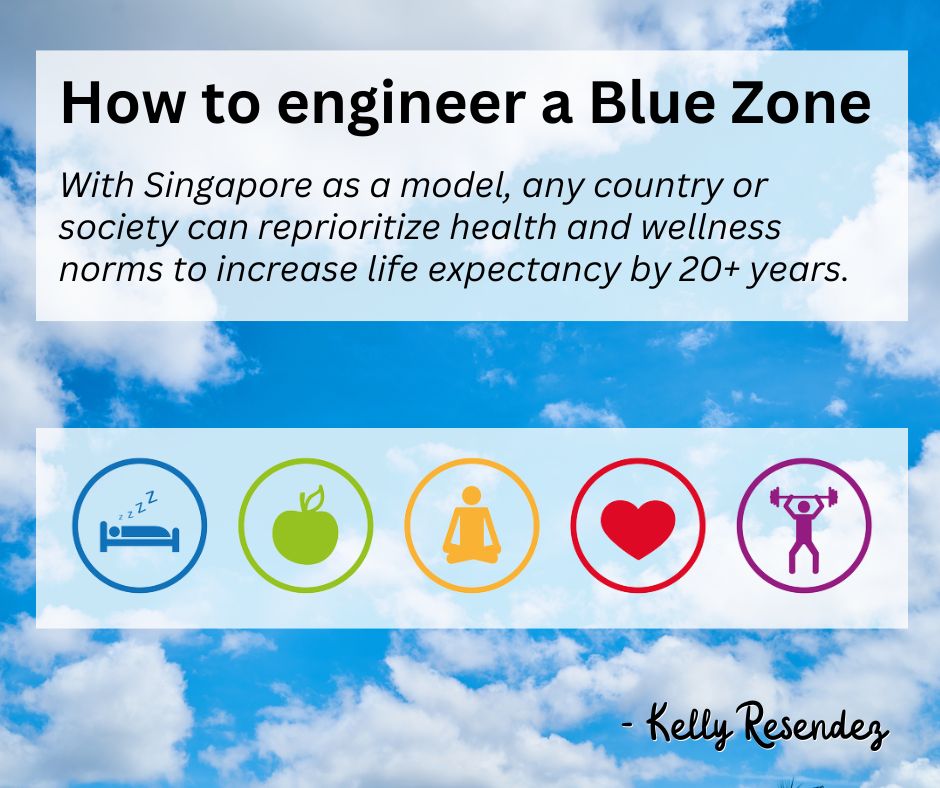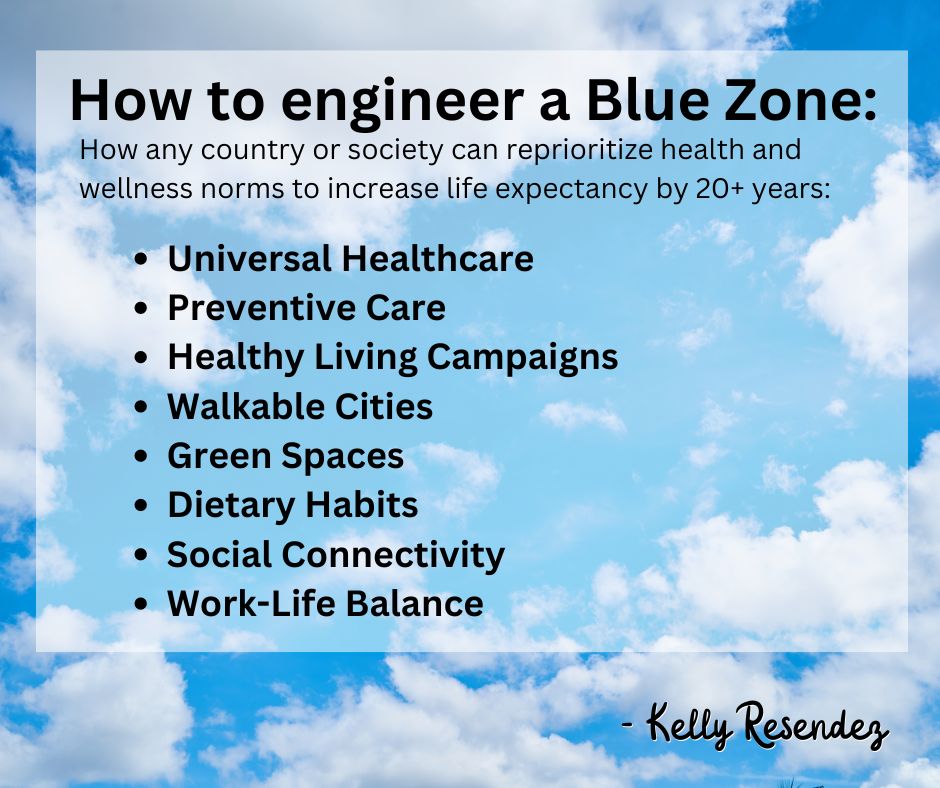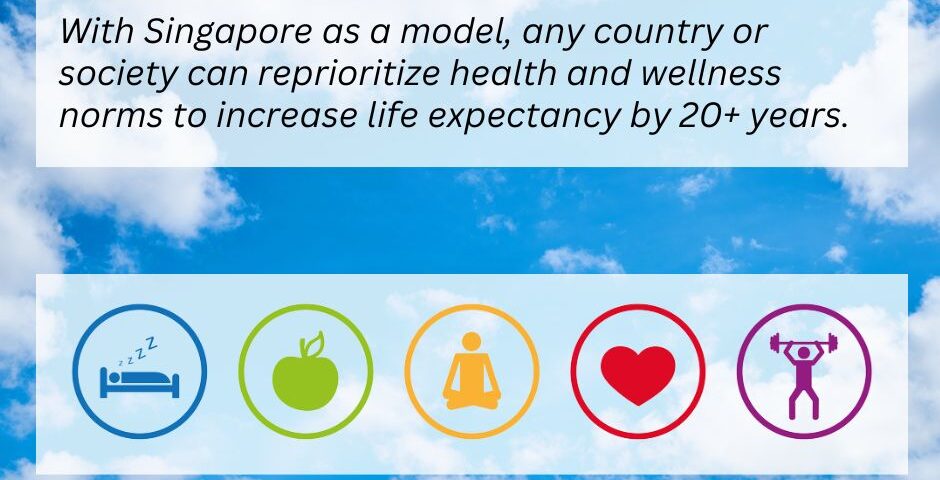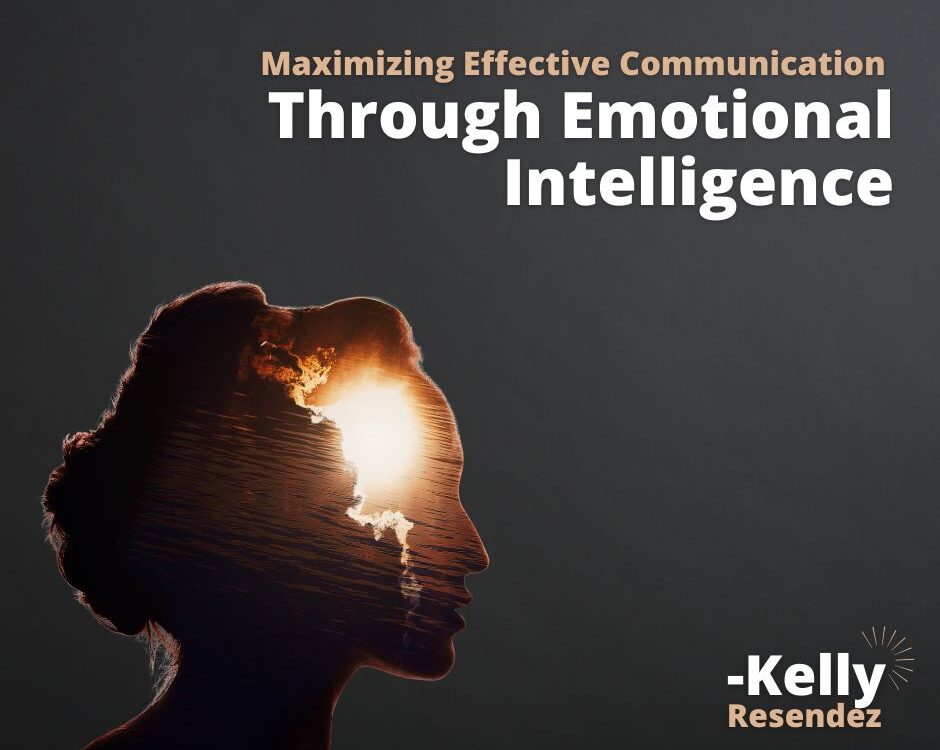
Tools to combat negative self-talk (and the key to that life-changing shift!).
July 15, 2024
The Power of Vulnerability in Leadership
September 23, 2024
With Singapore as a model, here’s how any society can reprioritize health and wellness norms to increase life expectancy by 20+ years.
You’ve heard of Blue Zones, right?
Those are the places around the world where people live significantly longer than average, often reaching ages beyond 90 and even 100 with great quality of life and low instances of chronic disease.
The original Blue Zones were identified for their naturally occurring longevity hotspots with several factors in common, including diet, cultural norms, social connection, and more. Those regions include Okinawa in Japan, Ikaria in Greece, Sardinia in Italy, Nicoya in Costa Rica, as well as Loma Linda in California.
But what if a Blue Zone could be engineered?
Instead of being inherent to these areas that share these conditions, what if a country or society could actually use those as a formula for health, wellness, and longevity, essentially manufacturing a Blue Zone?
It’s possible, as one nation has now become the world’s sixth Blue Zone and the only one that was engineered to produce those results. While natural Blue Zones have existed for generations, this country presents a unique case study of a Blue Zone that has been intentionally designed and implemented through policy, culture, and community initiatives.
We zoom all the way across the world to the island nation of Singapore for our 6th Blue Zone.
Known for its strict laws on behaviors in public like spitting or chewing gum, Singapore is also recognized as one of the healthiest, happiest, and longest-living places on Earth; but that wasn’t always the case.
Singapore’s unique journey to become a Blue Zone.
Back in the 1960s, Singapore was considered a developing nation, with limited resources, antiquated ideas, and poor public health. As a result, in 1960, the average life expectancy at birth in Singapore was just 65 years.
Today, that figure has increased by nearly 20 years, with average life expectancy in Singapore currently at 84.9 years, a remarkable transformation in just a couple of generations!
That’s also six years more than the average life expectancy in the United States.
Moreover, Singaporeans enjoy the highest healthy life expectancy and the lowest cardiovascular mortality rate in the world, supported by an exceptional healthcare system.
The number of centenarians on the island has more than doubled over the past decade, from 700 to 1,500, along with a significant increase in the population of those in their eighties and nineties.
Singapore’s incredible transformation to a Blue Zone did not happen overnight. This small city-state has achieved remarkable health outcomes over the past few decades through comprehensive planning and strategic initiatives by its government, supported by cultural shifts among its people.
Back in the late 1960’s, the government prioritized health and education as cornerstones of national development, recognizing that a healthy population was essential for economic growth.
Investments in healthcare infrastructure, sanitation, and education laid the foundation for a healthier population, to the point where it is now ranked among the highest in the world for health and life expectancy.
So, how did Singapore do it?
And how can any nation, society, or even family replicate those conditions to achieve the same results?
It’s not just one thing that will dictate the transformation to Blue Zones. In fact, Singapore’s success as an engineered Blue Zone can be attributed to a multifaceted approach that integrates health-focused policies, cultural practices, and community engagement.
Here’s how they did it:
1. Changes in government policies and the healthcare system.
The Singaporean government plays a pivotal role in shaping and promoting a healthy environment. Some of their key initiatives include:
- Universal Healthcare: Singapore provides a top-notch healthcare system that emphasizes accessibility and affordability. The government subsidizes healthcare costs, ensuring that quality medical care is available to all citizens.
- Preventive Care: Preventive healthcare is a real focus for citizens through regular health screenings, vaccinations, and health education campaigns. This proactive approach helps detect and address health issues early.
- Healthy Living Campaigns: Nationwide campaigns encourage healthy lifestyles, from stop-smoking programs to initiatives promoting physical activity and balanced diets.
2. A shift in urban planning and public spaces to promote healthy living.
Singapore’s urban planning is designed to promote physical activity and well-being:
- Walkable City: The city is meticulously planned with pedestrian-friendly infrastructure, making it easy for residents to walk or cycle to work, school, or leisure activities. Residents are highly incentivized to walk or bike to work or around the city.
- Green Spaces: Parks and nature reserves are integral to Singapore’s landscape, providing residents with access to nature and recreational opportunities.
- Public Transport: An efficient and accessible public transport system reduces reliance on cars, contributing to cleaner air and encouraging residents to incorporate more physical activity into their daily commutes.
3. A focus on cultural practices and community engagement.
Aside from governmental initiatives, Singapore’s culture and familial norms promote practices that contribute to longevity:
- Dietary Habits: Singaporean cuisine is influenced by various cultures, emphasizing a balance of nutrients. The government encourages healthy eating through guidelines and public awareness campaigns, promoting reduced sugar and salt intake.
- Social Connectivity: Strong family ties and community support networks are integral to Singaporean culture. Social activities, community centers, and cultural events foster connections and combat loneliness.
The importance of social connection and life with “meaning” can’t be underestimated in Blue Zones!
- Work-Life Balance: Recognizing the importance of mental health, Singapore promotes work-life balance through policies such as flexible work arrangements and initiatives supporting mental well-being.
Lessons we can learn from Singapore’s engineered Blue Zone.
Sure, it’s a lot easier to create a Blue Zone in a small city/state (Singapore has a population shy of 6 million people) that was carefully constructed by an authoritarian (yet benevolent) government. It may not be possible to replicate the conditions needed to create a Blue Zones in the United States with 350+ million people, vast diversity, and a decentralization of government with state’s rights.
However, it is possible to have Blue Zones within the U.S., as is evidenced by one of the world’s five existing pockets of longevity (in Loma Linda, California).
And Singapore’s journey can offer us valuable lessons for creating engineered Blue Zones, even right in our backyard. The nation’s success demonstrates that a comprehensive approach with better government policies, urban planning, cultural practices, and community engagement can really change the landscape for health, wellness, and longevity.
But we can promote these same initiatives in our own city, our neighborhood, or even within our own families. Singapore proves the blueprint for engineering a better, healthier life, and it’s one we’d be wise to follow!




